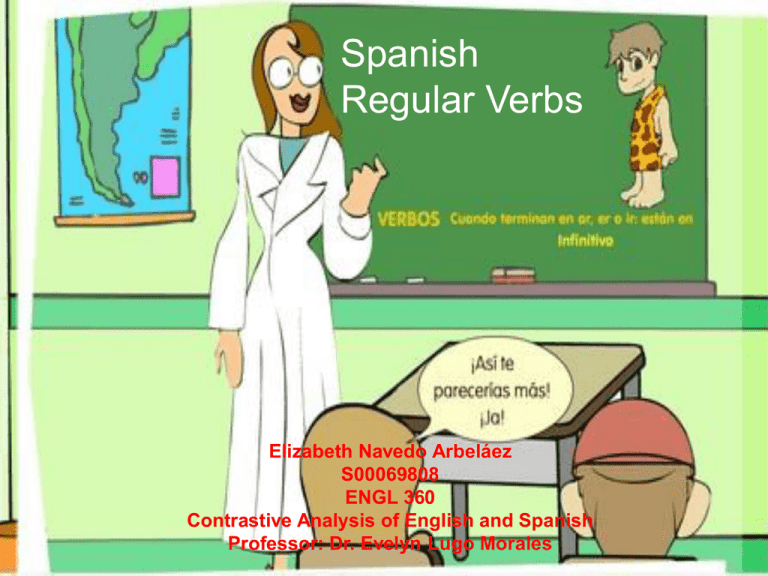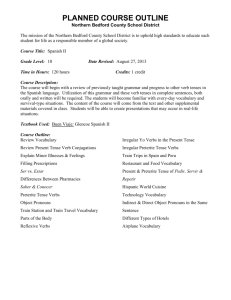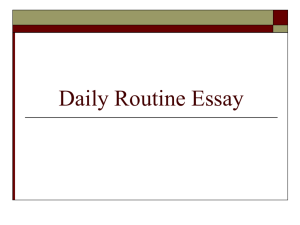Spanish Regular Verbs
advertisement

Spanish Regular Verbs Spanish Regular Verbs Elizabeth Navedo Arbeláez S00069808 ENGL 360 Contrastive Analysis of English and Spanish Professor: Dr. Evelyn Lugo Morales Spanish Regular Verbs • Spanish Regular Verbs are those verbs that conjugate in a totally uniform way, without modifying their stem, and empolying the corresponding ending in every mode and time to the conjugaction to which it belongs. • In the Spanish Regular Verbs the stem is the part that expreses it’s infinitive way. • It identifies the action that the verb enunciates • Verbs in Spanish act differently from verbs in English • Infinitive is the unconjugated form of a verb, such as " to write," " to be," " to want," " to run." • Conjugation is the process of changing the form of a verb to reflect the desired tense and subject Spanish Regular Verbs • • • Verbs in Spanish not only contain information about when the action took place (the tense), but also who performed the action (the subject). In Spanish there are three categories of verbs: -ar; -er; and -ir. The unstressed present tense endings for -er and -ir verbs are essentially the same as for -ar verbs, except that the a vowel of the ending is replaced by e (so instead of -as, the tú form ends in -es etc): Person Ending Example with COMER Example with VIVIR Example with AMAR yo – I o yo como – I eat yo vivo – I live yo amo – I love tú – you es / as tú comes – you eat tú vives – you live tú amas – you love él/ella he/she e/a el / ella come – he /she eats el / ella vive he / she lives el/ella ama – he / she loves ellos/ ellas – they en / an ellos / ellas comen they eat ellos/ellas viven they live ellos/ellas aman they love Spanish Verbs • There are many Spanish verbs (like ser and estar) that convey distinctions in meanings that do not exist in English. • Singular Subject Plural Subject Yo (I) soy Nosotros/as (we) somos Tú (familiar you) eres Vosotros/as (familiar you) sois Usted, él, ella (polite you, he, she) es Ustedes, ellos, ellas (you, them) son • All Spanish verbs are either "regular" or "irregular • Spanish verbs have many more possibilities in its simple forms. • Spanish verbs pack all of the following into a single word form: verb stem + tense marker + person marker Spanish Verbs • For example, the word veíamos is from the Spanish verb ver, meaning to see, to watch. • The form veíamos normally means something like "we were watching" (as in we were watching TV), and can be broken down into the following parts: The verb stem: ve-, which identifies which verb it is The tense marker: -ía-, which marks this form as a tense usually referred to as the imperfect The person marker: -mos, meaning "we" Spanish Regular Verbs It is important to know the stem of the verb so that you can add the endings to it, like the stem of hablar is habl, comer: com, vivir: viv. I speak = yo + habl+o = yo hablo. present participle, past participle, present indicative, preterit indicative, Imperfect indicative, future indicative, imperative (Commands). Verb Pr Part Pa Part Present Preterit Imperfect Future Reg. hablando -ar hablado Hablo, as, a, amos, an Hablé,a Hablaba, ste, ó s, mos, n Hablaré Habla, , ás, á, hablad emos, án Reg. comiendo comido -er Como, es, e, emos, en Comí, iste, ió, imos, ieron Comía, s, mos, n Comer é, ás, á, emos, án Come, comed Reg. viviendo -ir Vivo, es, Viví, e, imos, iste, ió, en imos, ieron Vivía, s, mos, n Viviré, ás, á, emos, án Vive, vivid vivido Imperative Spanish Verbs • The above formula of stem + tense + person makes things look simpler than they actually are. • In many verb forms, there are complications in how these parts are actually put together. • Some verbs have irregular stems, which in turn can depend on the tense. So in that sense, the "stem" and "tense" part of the verb form aren't quite so separate all the time. • Although the ending -mos works for all forms, other persons such as the I form, can actually have different endings depending on the tense. • The "tense" and "person ending" parts of the verb form aren't always quite so separate either. Spanish Regular Verb in Present Tense Preterit Yo indicative (pretérito de indicativo Tú Ud./él/ella Nosotros/as Vosotros/as Uds./ellos/ellas Hablar Speak/ talk Hablo Hablas I You speak speak Habla He/she speaks Hablamos We speak Habláis Hablan They speak Comer Eat Como Comes I eat You eat Come Comemos He/she eat We eat Coméis Comen They eat Vivir Live Vivo I live Vive He/she lives Vivís Viven They live Vives You live Vivimos We live Contrast between English and Spanish In English, the subject has to be specified before the verb In Spanish, the information can be contained in a single word. • I write (present tense) • I wrote (past tense) • We will write (future tense) • Escribo (present tense) • Escribiste (preterit past tense) • Escribiremos (future tense) Contrast between English and Spanish Spanish hablar • yo hablo • usted habla • nosotros/as hablamos • ustedes hablan comer • yo como • usted come • nosotros/as comemos • ustedes comen vivir • yo vivo • usted vive • nosotros/as vivimos • ustedes viven English to speak • I speak • you speak • we speak • you-all speak to eat • I eat • you eat • we eat • you-all eat to live • I live • you live • we live • you-all live Imperfect tense Conditional tense Future tense Preterit Imperative Imperfect tense • A past tense that is a single word in Spanish (i.e. it is a simple tense) • Often translated in English by used to … or was / were … ing • Generally used to describe an event or state but without viewing its “end point” • The form of the imperfect tense in Spanish fall in two patterns: -ar; -er; and -ir. • The form of the imperfect tense of –ar verbs which are based on the ending -aba plus a person ending in some cases. • The form of the imperfect tense of -er and -ir verbs is formed using a different set of endings. • The basic pattern is that the infinitive ending (-er or -ir) is replaced with -ía. Then, regular person endings are added where necessary. • Almost all verbs commonly classed as "irregular" ending in -er/-ir also follow this pattern. Imperfect tense of –ar verbs - ar verbs have imperfect tense forms ending in – aba – (plus a person ending) Person Stem - aba Person form ending yo Cantaba I used to sing; I was singing tú -aba- -s- él/ella nosotros-as Imperfect form Cantabas You used to sing; you were singing Cantaba He/she used to sing ; he/ she was singing Cant- -ába- mos vosotros-as -is- Cantábamos We used to sing; we were singing Cantabais You (all )used to sing; you were (all) singing -abaellos/ellas -n- Cantaban They used to sing; they were singing Imperfect tense of –er and –ir verb Adding -ía then the person endings, this gives the following endings for the imperfect of -er and -ir verbs: Person Ending Example Yo -ía Hacer > hacía I was making/doing, I used to to/make Tú -ías Comer > comías You were eating, you used to eat Él/ellas -ía Escribir > escrbía He/she was writing, he/she used to write Nosotros, -as -íamos Leer > leíamos We were reading, we used to write Vosotros, - as -íais Vender > vendíais You were (all) selling, you (all) used to sell Ellos/ellas -ían Correr > corrían They wer running, they used to run Future Tense • Spanish verbs have a single-word form that carries roughly the meaning of English will or 'll (as in we will try, he'll eat, they'll come etc). • The future tense of most verbs consists of the infinitive plus an ending. • Occasionally, a slightly modified form of the infinitive is used (vendrá, not venirá). Future indicative (futuro indictivo) yo tú Usted/ él/ella Nosotros /as Vosotros /as Ustedes/ ellos/ellas Hablar Speak/ talk Hablaré I will speak/ Talk Hablarás You will speak/ Talk Hablará He/she will speak/talk Hablaremos Hablaréis We will speak/talk Hablarán They will speak/talk Comer Eat Comer é I will eat Comerás You will eat Comerá He/she will eat Comeremos Comeréis We will eat Comerán They will eat Vivir Live Viviré I will live Vivirás You will live Vivirá He/she will live Viviremos We will live Vivirán They will live Viviréis Conditional Verb Forms • Spanish has a single-word verb form that roughly corresponds to English would/'d .... • It generally expresses either (a) something that would happen based on a condition (the condition may be implied rather than stated), or (b) future-in-the-past. Examples of Spanish conditional forms: lo haría si... I'd do it if... dijo que vendría he said he'd come Spanish Regular Verb Preterit (past tense) The Preterit is equal to the past tense. Preterit yo indicative (pretérito de indicativo) tú usted/ él/ella Nosotros/ Vosotros/ as as Ustedes/ ellos/ ellas Hablar Speak/ talked Hablé I spoke/ talked Hablaste You spoke/ Talked Habló He/she spoke/ talked Hablamos We spoke/ talked hablasteis Hablaron They spoke/ Talked Comer Eat Comí I ate Comiste You ate Comió He/she ate Comimos We ate comisteis Comieron They ate Vivir Live Viví I lived viviste You lived Vivió He/she lived Vivimos We lived vivisteis Vivieron They lived Spanish Regular Imperative Verbs The imperative or command verb in Spanish are like giving orders to others. Commands (Mandatos) Tú Vosotros/as Usted Ustedes Hablar Speak ¡Habla! ¡No hables! ¡Hablad! ¡No habléis! ¡Hable ¡No hable! ¡Hablen! ¡No hablen! Comer Eat ¡Come! ¡No comas! ¡Comed! ¡No comáis! ¡Coma! ¡No coma! ¡Coman! ¡No coman! Vivir Live ¡Vive ¡No vivas! ¡Vivid! ¡No viváis! ¡Viva! ¡No viva! ¡Vivan! ¡No vivan! References • http://www.rocketlanguages.com/spanish/resources/spanish_verbs. php • http://www.studyspanish.com/lessons/regverb1.htm • http://www.escueladigital.com.uy/espaniol/verbos_reg.htm • http://www.espanol-ingles.com.mx/spanishgrammar/verbs_introduction.shtml • http://quizlet.com/334380/regular-spanish-verbs-meanings-flashcards/ • http://spanish.speak7.com/spanish_regular_verbs.htm






